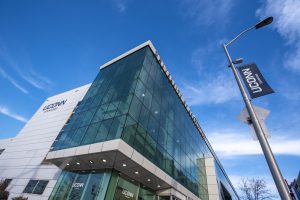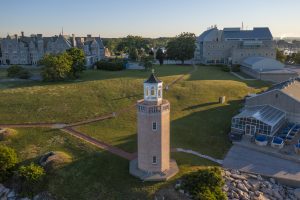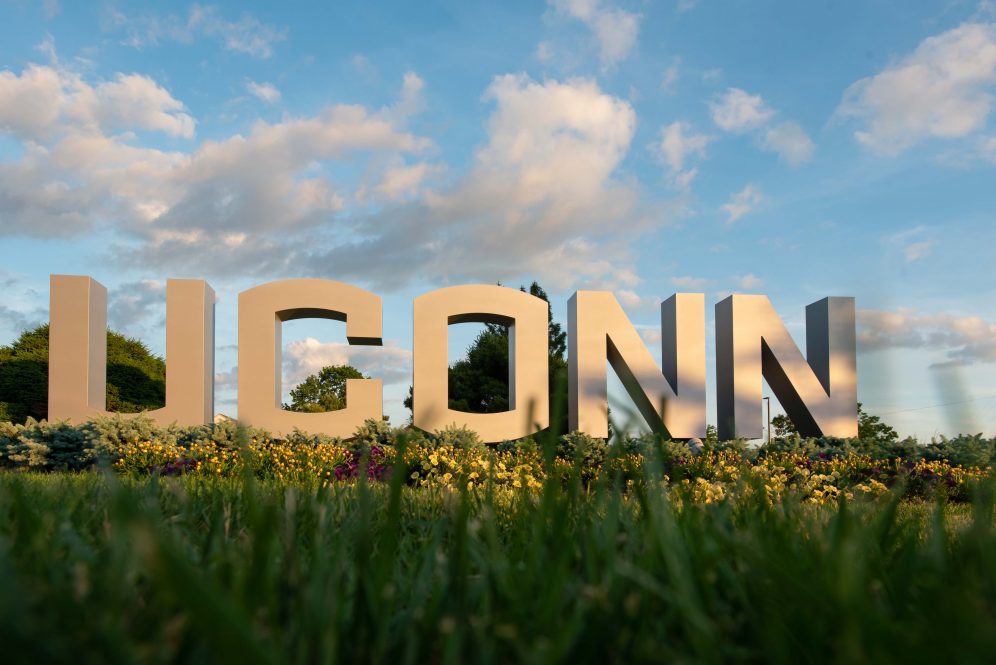The new academic year brings a rich variety of new offerings at UConn’s regional campuses, which are increasingly popular choices for new and continuing students based on their unique assets and those of their host communities.
About 2,000 first-year students are expected to start classes Monday at the campuses in Avery Point, Hartford, Stamford, and Waterbury in addition to approximately 4,500 first-year students starting at Storrs.
Overall, about 5,100 of UConn’s estimated 19,800 undergraduates for the 2024-25 academic year will count one of those locations as their home campus. The numbers are estimates, with the official figures being tallied after the 10th full day of classes.
With the vast majority of all regional campus students being Connecticut natives, those locations offer the benefits of a UConn education with the convenience of being in communities where students can live, work, and socialize.
UConn has prioritized a commitment to expanding its regional campus offerings as part of its Strategic Plan, building on each location’s strengths to make them destinations for students interested in specific majors or programs.
As part of that work, UConn has added more student services to each regional campus, including more advising support and expanded on-site Student Health & Wellness offerings such as nurse navigators, mental health clinical care case workers, and health promotion programs.
Each campus also offers academic and social clubs, library and research resources, small courses with experienced faculty, and programs to help students engage with the communities in which the campuses are located.
“As our Strategic Plan says, we want everyone to have the full UConn experience no matter which locations or programs they choose,” says Nathan Fuerst, UConn’s vice president for student life and enrollment. “The Hartford, Stamford, Avery Point, and Waterbury campuses are a truly special part of the University, and we’re excited for our students in each of them to enjoy another great year ahead.”
STAMFORD

It’s a good time to be at UConn Stamford — so says a record number of new and returning students who’ve chosen it as their academic and social home base for the coming academic year.
Driven by unprecedented interest and record-setting applications from aspiring first-year students, UConn Stamford will have its highest-ever undergraduate enrollment in the 2024-25 school year.
UConn Stamford originally expected to have about 800 first-time students this semester. However, interest was so strong that the campus is the new home to almost 1,000 first-time students, along with about 100 students transferring from other institutions.
Overall, the campus will be home to about 2,600 undergraduates, an increase of 400 over last year — and an indicator that UConn Stamford has become a popular destination for its wide array of offerings, convenient downtown location, and welcoming campus community.
The University is adding 25 new classes to accommodate the enrollment increase, along with many more sections in the First Year Experience course to ensure that every new student is able to benefit from its offerings.
With about half of UConn Stamford’s students being the first generation in their families to attend college, the campus is particularly focused on ensuring they have access to support and opportunities to connect with others. To help with those goals, the campus is hosting a First-Generation Students breakfast event as part of its plans to kick off the new semester.
Residential life at UConn Stamford will also be vibrant in the coming year, with the addition of new living spaces to expand availability.
Stamford was the first regional campus to offer student housing when it opened the building at 900 Washington St., and interest has continued to grow. In fact, UConn has added beds elsewhere and increased capacity from 480 last year to 677 this year.
With beds now in six buildings easily accessible to the main campus, UConn Stamford will host student move-in on a staggered schedule on Friday, Saturday, and Sunday.
The campus kicks off the semester Monday with a large convocation ceremony for first-year students, including welcomes from Stamford’s mayor, a local artist, faculty from the UConn schools and colleges represented on campus, and others.
“We are thrilled to be welcoming such a large class of students to our campus,” says Jennifer Orlikoff, UConn Stamford’s campus dean and chief administrative officer. “This enthusiasm for the Stamford campus supports our goal of being a destination campus, where students choose to attend UConn in this beautiful, vibrant city.”
WATERBURY

UConn Waterbury’s students will discover new academic, social, and community offerings when they return to that downtown campus, where special efforts are underway to enhance both scholastic and extracurricular experiences.
The new semester brings the launch of specializations in the Human Development & Family Sciences (HDFS) Department, allowing students to pursue either the Early Childhood Development (ECD) or the Early Childhood Development & Education (ECDE) pathway.
Like the addition of the allied health major at Waterbury a few years ago, the expansion of the HDFS offerings reflects the commitment of the campus and University to meeting the growing demand for education professionals throughout the region.
UConn Waterbury is also introducing two new Learning Communities: La Comunidad Intelectual (LCI) for students exploring Latinx identities, and the Ideas + Impact (I+I) program for those passionate about social impact and entrepreneurship.
These initiatives underscore UConn’s dedication to providing a holistic and inclusive educational environment for students from all walks of life and diverse interests at the Waterbury campus.
The programs also complement the efforts underway there in the RISE Scholar Program, which focuses on resilience, inclusion, success and equity, and its Camina Conmigo (Walk With Me) initiative at UConn Waterbury.
Campus leaders also recently announced the launch of Walkbury, an initiative designed to strengthen the connection between students and the vibrant downtown Waterbury area. It will kick off with free food and cultural tours early in the fall and provide students with maps to guide them to local businesses and historic landmarks, fostering a deeper connection between the campus and the community.
“We are thrilled to offer these new opportunities that not only enrich our students’ academic journeys but also integrate them into the heart of the Waterbury community,” says Fumiko Hoeft, UConn Waterbury’s campus dean and chief administrative officer.
“Our goal is to create a nurturing and dynamic environment where students can thrive academically, socially, and personally, contributing positively to the broader community,” she says.
UConn Waterbury does not offer University-run student housing, but developers are filling the need with existing and planned apartments within walking distance of the campus.
The Brown Building, which was built specifically to accommodate the needs of student renters, was the first nearby and draws about 70 UConn Waterbury undergraduates yearly.
The developer responsible for the Brown Building is also renovating a building adjacent to UConn Waterbury, which will lease a portion of it for academic, research and administrative purposes when it opens in 2025.
HARTFORD

Hartford was the site of UConn’s first regional campus, having opened in 1939 as an extension center – albeit in a different location than its current spot in the renovated Hartford Times building, where it moved in 2017.
This semester, its footprint is growing again with the planned opening of the University’s new Research Innovation Center at 229 Trumbull Street.
UConn is leasing space in that office building, which is known as Hartford 21 (H21) and fronts the XL Center in the city’s downtown core. The space will house lecture halls, academic centers, classrooms, and faculty offices, providing opportunities to partner on support for community engagement, and on research projects and research grants.
It’s also across the street from planned student housing that will open in fall 2026 if all schedules stay on track.
Given its central location in Connecticut’s capital city, UConn Hartford has particularly strong offerings in public policy, social work, business, urban and community studies, and other programs.
UConn Hartford’s research and academic missions are also highly infused with an emphasis on equity, justice, anti-racism, and community collaboration.
In that spirit, one of the new initiatives starting this semester is the UConn Hartford Dean’s Series, which will include three events focusing on activism at the University; the student vote; and post-election issues.
Those programs are also connected to ongoing community conversations being held every two weeks to allow what Campus Dean Mark Overmyer-Velázquez describes as “sustained critical reflection, refinement, and deeper inclusion.”
“During community conversations last spring, we heard from students, staff, and faculty that there is a need to continue to gather and learn together,” says Overmyer-Velázquez, who is also the chief administrative officer of the campus.
The student body is also highly diverse at UConn Hartford, which is a federally designated Asian American and Native American Pacific Islander Serving Institution (AANAPISI), and an emerging Hispanic-Serving Institution (HSI).
The new academic year will include new programs and supports under the TEAS project (Transformation, Equity, Access, and Sense of Belonging) grant awarded last year to address the needs of UConn Hartford’s rising number of Asian American students.
“UConn Hartford is excited to welcome new and returning students, and to help them benefit from the many initiatives in place to enrich their experience on campus and throughout the community,” Overmyer-Velázquez says.
AVERY POINT

There’s more in the air at Avery Point right now than just the ocean breezes that waft across the shoreline campus.
There’s also a sense of excitement over a vision currently being explored to offer student housing at that Groton location for the first time, along with the potential in coming years for additional four-year majors on site, such as engineering, to prepare students for jobs at local employers.
UConn and southeastern Connecticut regional officials have been discussing the potential for expansions at the Avery Point campus, including whether an external partnership may be possible in which students would have access to housing on or adjacent to the campus.
Avery Point students will also now be able to participate this fall in the University’s Discovery Leadership Certificate Series, in which they can develop those skills in preparation for heading up groups and other leadership initiatives.
“This program is essential because it shapes students into impactful leaders by cultivating self-awareness, honing practical skills, and deepening their understanding of team dynamics, communication, and cultural competence,” says Janene Vandi, Avery Point’s associate campus director. “It ensures that our students are equipped to navigate and influence the complex world around them.”
The Avery Point campus has more than 450 full-time students, including more than two-fifths who are the first generation in their families to enroll in college. Situated on Long Island Sound, it reflects the region’s proud maritime tradition and active leadership in science, technology, engineering, and mathematics (STEM) fields.



